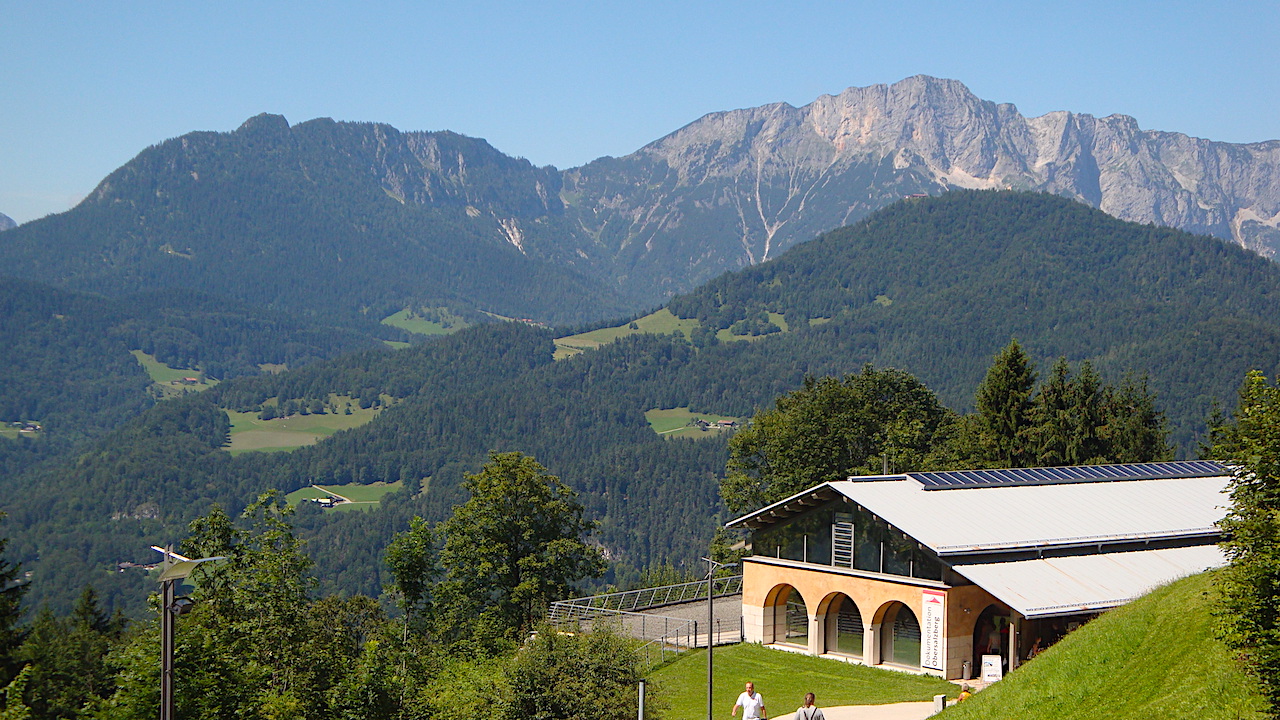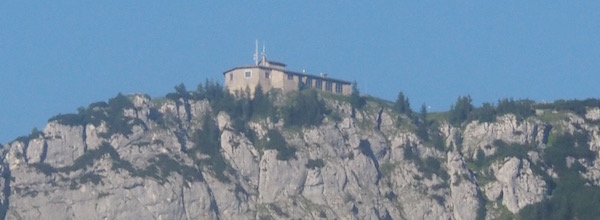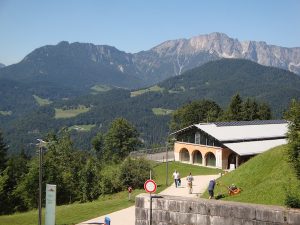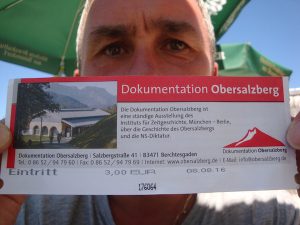When it comes to remembering my lessons at school, I have to be honest and say that History wasn’t my favourite – I was more interested in English and Geography. Although I do remember that the two Great World Wars of the last century most certainly made it onto our curriculum. And rightly so – they significantly shaped our lives today and so understanding how soldiers gave up their lives fighting for our freedom seems such an important lesson.
So when Myles, who is a bit of a history buff, said he wanted to go to Bavaria’s Berchtesgaden in South-east Germany to see Hilter’s summer retreat, it seemed like too good an opportunity to miss. For three nights, we wild-camped at the Visitor’s Centre in Konigssee, which itself is a must see, and from Scoobie’s door we had a bird’s eye view (if you pardon the expression) of Kehlsteinhaus – Eagle’s Nest. This is a lofty building constructed 1,834m up in the mountains above Obersalzburg, to mark Hilter’s 50th Birthday. It isn’t difficult to see why he retreated to this place, as it is literally on top of the world. I’m sure in some sense this was a symbolic location that fed his obsessional world, as it truly give him a bird’s eye view across his beloved kingdom.
Although it is now a restaurant, there are daily tours up there from May to October depending on the snowfall, where I guess you can get a feel for Hilter’s diplomatic soirees which he conducted up there during his Third Reich reign.
After the combination of rain, low cloud and weekend visitors had dispersed, we headed up the mountain towards the car park at Obersalzberg, in eager anticipation of what the day ahead might entail. We had read that in addition to the special bus ride that you must take up to Kehlsteinhaus, there was also the Dokumentation Obersalzberg, which is a museum recording Hitler’s rule. However our anticipation soon dissipated as we acknowledged the overcrowded car parks and streams of coaches full of visitors all looking to grasp that little piece of history from Hitler’s vantage point. Now it is worth mentioning at this point, that we don’t do queues at the best of times and in the middle of August, in increasingly warm temperatures, the prospect of joining this ensemble of tourists, which looked more like a trail of ants as the minutes went by, did not motivate us one bit. So we decided to visit the less-talked about Dokumentation Obersalzberg instead, which everyone seemed to be bypassing for some reason.
This unassuming building, erected in 1999 is an historical site, museum and a place of remembrance. It offers the visitor a detailed guide into the role that this Obersalzberg region played in Hitler’s carving of twentieth century history and a reflective tale of all those who perished under his reign. Not only that, this building holds many ghosts and secrets that are etched into the walls of the maze of bunkers, dug underneath this unassuming construction, which you are allowed to visit.
So with no queues and virtually the place to ourselves, we gathered up our 2€ Audio Guides (which apparently in German is Audio Guide!!!) and our 3€ a person entry ticket and entered into the halls of history. Now we did wonder, with curiosity, how the Germans would present this epoch of history, given its potentially sensitive nature and their patriotic values. So you can imagine our amazement when the first visual image you are greeted with is a huge poster of Hitler in dominant pose surrounded by crowds of adorning fans like he is some sort of pop idol. And then the images of the emaciated bodies of the concentration camps and public hangings of Jewish Priests, giving you a very clear message that this museum is going to offer a completely ‘no holds barred’ representation. It was at this point that the historical journey I was about to take would rip at my heart with unforgiving purpose.
What we didn’t realise was that this region of Bavaria known as Obersalzburg, was key in Hilter’s crafting of dominance. He bought a house on the mountain called Berghof and soon when the German population realised that this was his home, flocked here to capture a glimpse of him, to share the same air he breathed or a stone of gravel that he had walked upon. They even had to build the current day Train Station in Berchtesgaden to accommodate the crowds. So to protect his territory from invading patriots, Hitler removed the local residents, buying up their property for a pittance. If they refused his offer, the consequences were forcible eviction or even being sent to the concentration camp in Dachau. This was one of the many things that shocked me. I hadn’t realised that his Concentration Camp strategy was significantly before the outbreak of war. Millions died before war even broke out.
Berghof played a key role in his propaganda campaign which set about manipulating the population to appreciate his greatness. There were pictures that showed him as a child-friendly, father figure who loved nature. Equally there were pictures of him with his mistress Eva Braun and of him reading a paper with glasses on – both which he refused to have published because it showed him as being weak and unfocused.
The policies he put in place to raise a generation of Hitler’s youth started from the moment of birth – if children were born imperfect, not only where they ‘removed’, their mothers were sterilised to prevent them from having any more imperfect babies. At the age of 10 children were enlisted into Hitler’s Youth Groups, grooming them with his doctrines. His dominance was at every level, in every corner and there was no where for you to hide, especially if you happened to disagree with his vision.
The other thing we learnt about the Obersalzburg, was how on April 25 1945, the American allies carried out a bombing raid on this Nazi area, resulting in Hitler’s main residence being flattened – with only one wall now remaining. The raid was purely an act of defiance, as Hitler had already vanished into the depths of Berlin and the war, for all intents and purposes was over. It is reported that the flattening the area that had played such an important role in the execution of so many, either in concentration camps or on the battle field felt significant. And even more interestingly, we didn’t realise that the American’s occupied this region of Bavaria as a recreational area for US troops, building Golf Courses and hotels – and was only handed back to the Bavarian people in 1995. Never knew that!
The final piece of our Obersalzberg lesson was a trip into the largest remaining bunker of the maze that was built under the mountains linking the Nazi Leaders’ property. Now whilst the modern building housing the museum is fascinating and penetrates deep into your soul, this remaining piece of history is eerily decorated with ghosts from the past and graffiti from the American soldiers who occupied this area after the war. The bunker is damp, dark and silent with echoes of German plotting. Rooms set out as hospitals, kitchens, stores and toilets, all hallmark the underground life that epitomises Hitler’s reign and fight for dominance. There is nothing you can say as you walk through the tunnels, as they leave you haunted by the evil and the sense of death. Although this may not have been a place of physical death, it is most certainly the representation of death, as those who walked the floors of this Nazi maze were entirely responsible for the horror that will be with us for centuries to come. The man, that prior to World War 2 was the most loved leader in the world, soon turned into the most hated figure in history, responsible for the deaths of over 60 million people.
Coming out of the Dokumentation was a surreal experience as the museum draws you into its past and into the soul of the perpetrator who changed the world as we know it. How could you put that 90 minute’s experience into words? I felt very humbled by the whole thing and we both agreed that adding to that ant-line of tourists to visit the Kehlsteinhaus to see what was probably a stunning view, might feel a bit superficial after our historical submergence. So we left the queues, knowing that for us the Dokumentation remembrance tour had affected us deeply.
As we reflected, Myles acknowledged that this was just the experience he had hoped for, being able to fill in so many gaps of our historical tapestry. We felt bizarrely enriched by our visit, forever affected by its raw honesty and humbled by the death and fight of so many in their pursuit of our freedom. If you are ever in this region, we implore you to visit – there will be a bit of you that will never be quite the same again. Until then, ‘Lest we forget!’
For more WW2 articles from around Europe, click here.





A fantastic read this place has been on my list of places to visit for years now but my love of France has kept me away . I will one day soon visit this area
Hi Paul, glad you enjoyed it. It felt right to write what I experienced. Come SOON! France won’t be going anywhere and apart from rubbish internet, this area of Germany is stunning. Come SOON!!! If you love history, you will absolutely love this place for its ghosts, its echoes and its historical lesson.
Very interesting reading Karen, must having been quite emotional. Definitely not to be missed on our visit to Bavaria.
Most definitely not to be missed. Hope you enjoy it as much as we did.